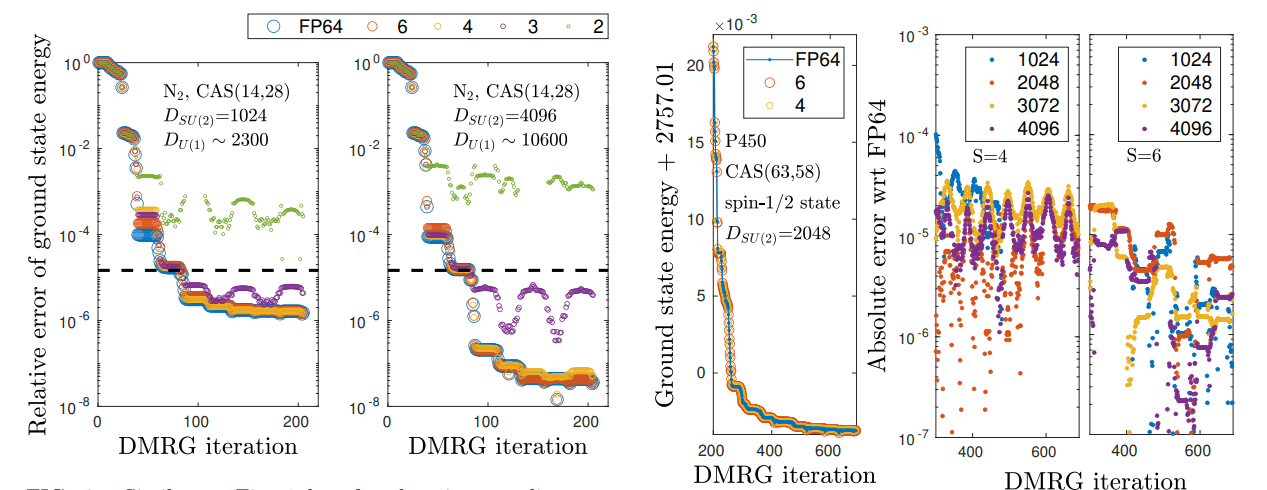Calculating the electronic structure of molecules accurately remains a significant challenge in computational chemistry and materials science, demanding ever more powerful computing resources. Cole Brower, Samuel Rodriguez Bernabeu, Jeff Hammond, and colleagues at NVIDIA, alongside Sotiris S. Xantheas from Pacific Northwest National Laboratory and the University of Washington, and Martin Ganahl from SandboxAQ, now demonstrate a pathway to achieving chemical accuracy using innovative mixed-precision calculations. The team successfully applies a novel approach, employing fixed-point arithmetic to emulate the precision of conventional double-precision calculations, and achieves results comparable to those obtained with standard methods on complex systems, including the iron-molybdenum cofactor (FeMoco) and cytochrome P450 (CYP) enzymes. This work represents the first evaluation of emulated double-precision arithmetic for correlated calculations, and it establishes a foundation for leveraging the power of NVIDIA’s Blackwell technology in advanced electronic structure calculations, promising breakthroughs in diverse fields from materials discovery to drug design.
DMRG Convergence, Precision, and Implementation Choices
This research provides a detailed exploration of the performance of the Density Matrix Renormalization Group (DMRG) algorithm, focusing on how numerical precision and implementation choices affect convergence. Scientists investigated bottlenecks in DMRG calculations, particularly when tackling large systems and demanding accuracy. They examined how computational choices, such as using central processing units (CPUs) versus graphics processing units (GPUs), the precision of Singular Value Decomposition (SVD), and the number of slices, influence the algorithm’s convergence. Key findings reveal that the SVD step presents the most significant bottleneck, especially when using reduced precision on GPUs.
Switching to a CPU-based SVD implementation, even without increased precision, dramatically improves accuracy, suggesting that GPU implementations can accumulate errors hindering convergence. Utilizing native FP64 precision on GPUs also resolves this issue. The number of slices used in the DMRG algorithm also significantly impacts convergence; using a small number leads to slower and less accurate results, while increasing the number improves performance. Full FP64 precision is vital for achieving accurate results, particularly when pushing the limits of system size and accuracy.
Mixed Precision DMRG for Accurate Electronic Structure
Scientists pioneered a novel computational approach to electronic structure calculations, achieving chemical accuracy while circumventing the limitations of traditional double-precision arithmetic. The study harnessed mixed-precision spin-adapted Density Matrix Renormalization Group (DMRG) calculations, employing the Ozaki scheme to emulate FP64 arithmetic using fixed-point compute resources. This innovative method approximates complex matrix and tensor algebra by operating on a modest number of fixed-point representatives, termed “slices”, significantly reducing computational demands without sacrificing accuracy. Researchers successfully demonstrated the viability of this approach on benchmark systems and, crucially, applied it to the active compounds of the FeMoco and cytochrome P450 (CYP) enzymes, achieving complete active space (CAS) sizes of up to 113 electrons in 76 orbitals and 63 electrons in 58 orbitals.
The team systematically interpolated between double- and pseudo-half-precision to perform detailed numerical error analysis and performance assessment of key DMRG algebra subcomponents. This work represents the first quantum chemistry evaluation of FP64 emulation for correlated calculations capable of achieving chemical accuracy using fixed-point arithmetic. The study’s success paves the way for utilizing state-of-the-art Blackwell technology in tree-like tensor network state electronic structure calculations, opening new avenues for research in materials science and beyond. Furthermore, the variational nature of DMRG provides an ideal tool to benchmark accuracy domains and assess the performance of emerging hardware and numerical libraries, solidifying its role in advancing computational chemistry.
Mixed Precision Enables Accurate Enzyme Calculations
Scientists achieved cutting-edge performance in electronic structure calculations by employing mixed-precision arithmetic within the Density Matrix Renormalization Group (DMRG) method. The research team utilized the Ozaki scheme to emulate FP64 arithmetic using fixed-point compute resources, demonstrating chemical accuracy in calculations for complex systems, including the active compounds of the FeMoco and cytochrome P450 (CYP) enzymes, achieving complete active space (CAS) sizes of up to 113 electrons in 76 orbitals and 63 electrons in 58 orbitals. The study represents the first evaluation of FP64 emulation for correlated calculations capable of achieving chemical accuracy using fixed-point arithmetic. Detailed numerical error analysis was performed on subcomponents of the DMRG algebra, systematically interpolating between double- and pseudo-half-precision to assess performance.
Results demonstrate the viability of this approach for high-accuracy quantum chemistry, paving the way for utilizing state-of-the-art Blackwell technology in tree-like tensor network state calculations. This work showcases a highly efficient, hardware-accelerated implementation of DMRG on NVIDIA DGX B200 GPUs, enabling highly accurate, ab initio quantum-chemical electronic structure calculations in mixed-precision arithmetic. The team’s SU(2)-aware implementation of the DMRG algorithm, combined with the emulation of FP64 arithmetic, opens new research directions in materials science and beyond by providing a pathway to tackle multi-reference systems with improved accuracy and efficiency.
Mixed Precision Enables Accurate Chemical Simulations
Researchers have achieved a significant advance in electronic structure calculations by demonstrating high accuracy with reduced numerical precision. Utilizing a mixed-precision approach within the Density Matrix Renormalization Group (DMRG) method, the team successfully emulated high-precision calculations using fixed-point arithmetic and a limited number of computational “slices”, opening possibilities for more efficient computation. The study involved detailed error and performance analysis, systematically varying computational precision to assess its impact on results. They found that while reducing precision can maintain accuracy, extremely low precision limits can lead to unphysical results, highlighting the importance of careful calibration.
Benchmarks performed on the DGX B200 system showed performance comparable to existing hardware, with anticipated improvements through optimized software libraries. This achievement paves the way for utilizing state-of-the-art Blackwell technology in tree-like tensor network state calculations, potentially broadening research in materials science and related fields. The authors envision straightforward implementation of this mixed-precision arithmetic within the DMRG-SCF framework for orbital optimization, further enhancing the method’s capabilities. This research represents a substantial step towards more efficient and scalable electronic structure calculations, with implications for a wide range of scientific disciplines.
👉 More information
🗞 Mixed-precision ab initio tensor network state methods adapted for NVIDIA Blackwell technology via emulated FP64 arithmetic
🧠 ArXiv: https://arxiv.org/abs/2510.04795

